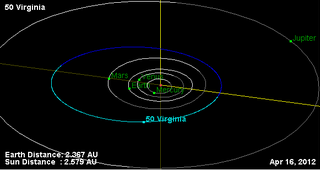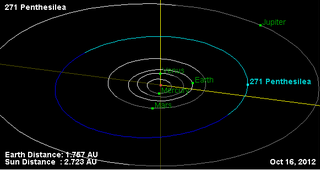
Virginia is a large, very dark main belt asteroid. It was discovered by American astronomer James Ferguson on October 4, 1857, from the United States Naval Observatory in Washington, D.C. German astronomer Robert Luther discovered it independently on October 19 from Düsseldorf, and his discovery was announced first.

Dejanira is a main belt asteroid that was discovered by Alphonse Borrelly on 1 December 1875, and named after the warlike princess Deianira in Greek mythology. The Dejanira family of asteroids is named after it.

Phthia is a bright-coloured, rocky main belt asteroid that was discovered by German-American astronomer Christian Heinrich Friedrich Peters on September 9, 1878 in Clinton, New York and named after Phthia, a region of Ancient Greece.

191 Kolga is a large, dark main-belt asteroid that was discovered by German-American astronomer C. H. F. Peters on September 30, 1878, in Clinton, New York. It is named after Kólga, the daughter of Ægir in Norse mythology.

Ambrosia is a main belt asteroid that was discovered by the Corsican-born French astronomer J. Coggia on February 28, 1879, and named after Ambrosia, the food of the gods in Greek mythology.

Weringia is a typical main-belt asteroid. It was discovered by Johann Palisa on 19 July 1882, and was named after Währing, part of Vienna, the city where the asteroid was discovered. Photometric observations during 2008 showed a rotation period of 11.1496 ± 0.0009 hours and a brightness variation of 0.20 ± 0.02 in magnitude.

Adrastea is a main belt asteroid. It was discovered by Johann Palisa on 18 August 1884 in Vienna, and was named after the Greek nymph Adrasteia. This asteroid is orbiting the Sun at a distance of 2.97 AU with a period of 5.11 years and an eccentricity (ovalness) of 0.23. The orbital plane is tilted at an angle of 6.17° to the plane of the ecliptic.
Walpurga is a large Main belt asteroid. It was discovered by Johann Palisa on 3 April 1886 in Vienna and was named after Saint Walburga.

Valda is a main belt asteroid that was discovered by Austrian astronomer Johann Palisa on 3 November 1886 in Vienna. The name was proposed by Bettina von Rothschild.

Libussa is a Main belt asteroid that was discovered by C. H. F. Peters on December 22, 1886, in Clinton, New York and was named after Libussa, the legendary founder of Prague. It is classified as an S-type asteroid.

Penthesilea is a mid-sized main belt asteroid that was discovered by Viktor Knorre on 13 October 1887 in Berlin. It was his last asteroid discovery. The asteroid was named after Penthesilea, the mythical Greek queen of the Amazons.

Eduarda is a main belt asteroid that was discovered by German astronomer Max Wolf on 25 September 1892 in Heidelberg. It was named after German banker and amateur astronomer Heinrich Eduard von Lade.

Ducrosa is a typical Main belt asteroid. It was discovered by Auguste Charlois on 15 March 1895 in Nice.

402 Chloë is a large main-belt asteroid. It was discovered by French astronomer Auguste Charlois on 21 March 1895 from Nice. This asteroid is orbiting the Sun at a distance of 2.56 AU with a period of 4.09 years and an eccentricity of 0.11. The orbital plane is inclined at an angle of 11.8° to the plane of the ecliptic.
Cheruskia is a minor planet, specifically an asteroid orbiting in the asteroid belt that was discovered by German astronomer Paul Götz on 26 July 1905 from Heidelberg.
618 Elfriede is a minor planet orbiting the Sun. On July 24, 2013, it occulted the magnitude 12.8 star 2UCAC 23949304, over parts of Mexico and southwestern United States.
880 Herba is a minor planet orbiting the Sun that was discovered by German astronomer Max Wolf on 22 July 1917 in Heidelberg.
947 Monterosa is a minor planet orbiting the Sun.
967 Helionape is an asteroid belonging to the Flora family of Main Belt asteroids. It was discovered by German astronomer Walter Baade at Hamburg Observatory on November 9, 1921, and was named after the Austrian theatrical actor Adolf von Sonnenthal. This object is orbiting the Sun at a distance of 2.23 AU with a period of 3.32 years and an eccentricity of 0.168. The orbital plane is inclined at an angle of 5.4° to the ecliptic.
999 Zachia is a main-belt asteroid that was discovered by German astronomer Karl W. Reinmuth in 1923 and named after Hungarian astronomer Franz Xaver von Zach.













